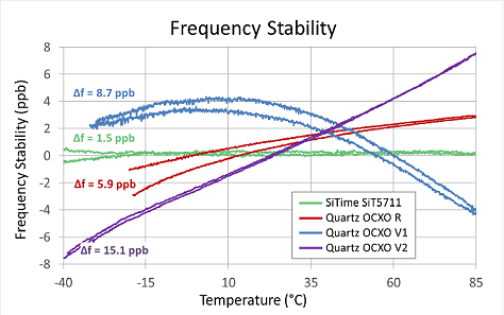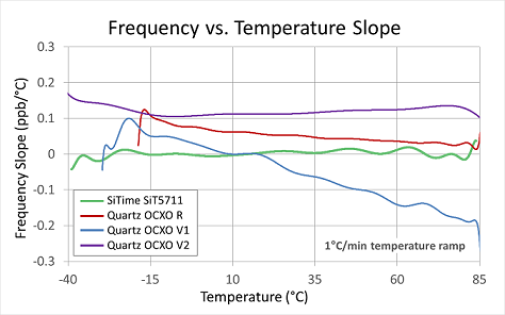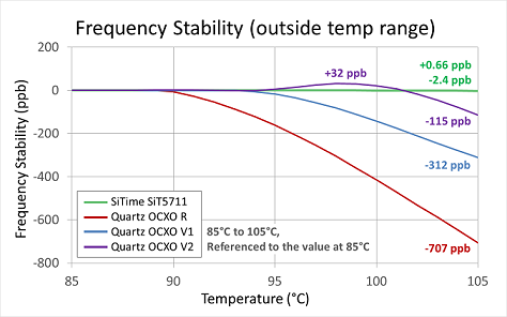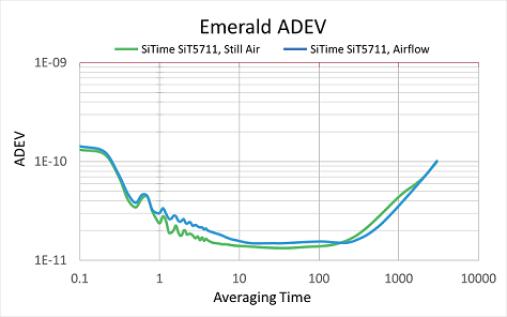A more robust Stratum 3E OCXO
In last week’s blog we discussed the basics of OCXOs—how they achieve precise stability, and how they can cause headaches, especially for board designers. Here we dive into the timing requirements for telecom applications, focusing on specifications relating to stability. And we unveil more details about the Emerald Platform™ OCXOs, a new game-changing Stratum 3E solution [1].
So what are the most important parameters for telecom? Let’s start with the basics…frequency stability, the most fundamental specification for an oscillator. This specification represents the deviation of output frequency due to external conditions. A smaller stability number means better performance. For OCXOs, frequency stability is typically expressed in parts per billion (ppb).
Temperature change is one of the main causes of frequency deviation. In the following plot we show frequency stability over temperature from -40°C to +85°C, as temperature rises and as temperature drops (hysteresis), for four different similarly-rated devices including a SiTime MEMS-based Emerald OCXO. The performance of the Emerald device (shown in the green line), with a delta of just 1.5 ppb, is four times better than the next closest OCXO.

Emerald devices have impressive frequency stability, which is key for synchronization applications such as Synchronous Ethernet (ITU-T G.8262) and IEEE 1588. This stability enables the oscillator to hold a stable clock when the system is in free run state through holdover [2] during network fault conditions. But what’s more important is maintaining this stability under real-world operating conditions such as rapid temperature changes, mechanical vibration, or other dynamic conditions that can affect the clock performance.
Let’s take a closer look at frequency vs temperature slope, a key metric for precision oscillators. Also known as ΔF/ΔT, this measurement quantifies the oscillator’s sensitivity to temperature change at 1°C increments. Here again, a lower number is better since it represents a deviation in frequency. Emerald products are rated at just 50 ppt/°C (ppt = part per trillion). The plot below shows the ΔF/ΔT performance of an Emerald OCXO compared to the same three quartz OCXOs.

Telecom systems use high-performance components that generate substantial heat and require cooling fans. As processors cycle and fans turn on and off, there can be significant temperature transients. But what happens when internal system temperature is compounded with unexpected and extreme external weather conditions? Or consider what could happen if a cooling fan malfunctions and internal temperatures significantly rise. The following plot shows how Emerald and quartz OCXOs behave above the normal industrial operating temperature range.

Stability in the time domain
Switching from the frequency domain to the time domain, let's look at Allan deviation (ADEV), another important metric for telecom engineers. ADEV is a measure of oscillator stability in the time domain and is sometimes called short-term frequency stability. ADEV is used because it converges for more types of oscillator noise compared to standard deviation. It accounts for things like phase modulation, frequency modulation, and random walk frequency. With 2e-11 ADEV at 10-second averaging time, Emerald devices maintain amazingly consistent performance. The plot below shows how Emerald devices perform with and without airflow.

Other common timing stability indicators for telecom applications include TDEV (time deviation) and MTIE (maximum time interval error). Both without and with airflow, Emerald OCXOs perform well within the specified ITU-T G.8262 EEC2 mask set as a standard for these measurements. Download our Emerald product brief to see TDEV and MTIE plots.
Robustness beyond temperature change
In addition to being resistant to airflow and rapid temperature change, Emerald OCXOs are virtually immune to vibration, which can also cause the frequency to shift. This resilience is critical since telecom equipment is often exposed to vibration, especially when deployed outdoors. Wind, heavy vehicles, and trains are just a few examples of the many sources of vibration. Emerald products deviate by only 0.1 ppb/g, making them ideal for outdoor pole-mounted equipment.
Beyond all of the external factors that can wreak havoc on oscillator stability, there can be internal changes within the oscillator that change the oscillator frequency over time, even while external environmental conditions are kept constant. This is called aging. Emerald OCXOs have excellent aging specs at ±0.25 ppb daily aging and ±500 ppb 20-year aging.
Emerald products are also immune to humidity and therefore don’t need additional sealing like traditional quartz OCXOs which are prone to leakage. And because Emerald devices have on-chip regulators, they’re immune to power supply noise that can degrade clock performance—so there’s no need for external LDOs or ferrite beads. Lastly, because Emerald products use silicon MEMS resonators, they have semiconductor-level quality and don’t suffer from batch-to-batch inconsistency like quartz OCXOs.
Solving the long-standing problems of fast-changing conditions
The Emerald Platform is resistant to a wide range of dynamic conditions. These devices are built to maintain stability in harsh environments where quartz OCXOs traditionally don’t hold up. Telecom equipment manufacturers no longer need to worry about the timing component being the weakest link in the system. And service providers can be less concerned about system failures and service interruptions due to timing. Emerald OCXOs provide consistently stable performance from batch-to-batch and from one environment to the next.
Watch for the next blog in our series on OCXOs to learn how new MEMS OCXOs make design and development easier with unique advantages related to programmability, size, and power.
………………………………………………………
[1] A Stratum 3 clock has a free run stability of ±4.6 ppm over 20 years and a hold-over requirement of ±0.37 ppm (±370 ppb) over 24 hours, both inclusive of frequency errors under all conditions. Stratum 3E is a more accurate version of Stratum 3, with the same ±4.6 ppm free run stability, but with ±0.012 ppm (±12 ppb) over 24 hour hold-over spec, 37 times tighter than Stratum 3.
[2] Holdover is a mode of operation used by systems that are synchronized to an external precision frequency and/or time reference, and that have temporarily lost this reference signal. The local oscillator should have the capability to maintain, or holdover, stable frequency and/or time within the defined limits in a system after the loss of the external reference.
For more information on timing terminology, download our Glossary of Oscillator Terminology.
………………………………………………………
Thanks to Jim Holbrook, Director of Customer Engineering, for his contributions to this article.